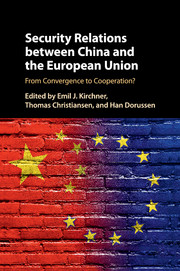Book contents
- Frontmatter
- Dedication
- Contents
- List of Tables
- Preface and Acknowledgements
- Abbreviations
- List of Contributors
- 1 EU–China Security Cooperation in Context
- 2 Chinese and EU Views of Military Security: Crafting Cooperation
- 3 Regional Solutions for Regional Confl icts? The EU, China and their Respective Neighborhoods
- 4 Aims versus Deeds: EU–China Cooperation in Nuclear Nonproliferation
- 5 Terrorism and Organized Crime: Common Concerns but Different Interests
- 6 Chinese and EU Climate and Energy Security Policy
- 7 Competing or Converging Claims on International Order? The EU, China and Human Security
- 8 Civil Protection: Identifying Opportunities for Collaboration
- 9 Cybersecurity and EU–China Relations
- 10 The Economic Security Dimension of the EU–China Relationship: Puzzles and Prospects
- 11 Is Securitizing Migration a Mandatory Choice? Lessons from the EU and China
- 12 Against the Odds: (Considerable) Convergence and (Limited) Cooperation in EU–China Security Relations
- Index
- References
4 - Aims versus Deeds: EU–China Cooperation in Nuclear Nonproliferation
Published online by Cambridge University Press: 05 September 2016
- Frontmatter
- Dedication
- Contents
- List of Tables
- Preface and Acknowledgements
- Abbreviations
- List of Contributors
- 1 EU–China Security Cooperation in Context
- 2 Chinese and EU Views of Military Security: Crafting Cooperation
- 3 Regional Solutions for Regional Confl icts? The EU, China and their Respective Neighborhoods
- 4 Aims versus Deeds: EU–China Cooperation in Nuclear Nonproliferation
- 5 Terrorism and Organized Crime: Common Concerns but Different Interests
- 6 Chinese and EU Climate and Energy Security Policy
- 7 Competing or Converging Claims on International Order? The EU, China and Human Security
- 8 Civil Protection: Identifying Opportunities for Collaboration
- 9 Cybersecurity and EU–China Relations
- 10 The Economic Security Dimension of the EU–China Relationship: Puzzles and Prospects
- 11 Is Securitizing Migration a Mandatory Choice? Lessons from the EU and China
- 12 Against the Odds: (Considerable) Convergence and (Limited) Cooperation in EU–China Security Relations
- Index
- References
Summary
EU–China cooperation in nuclear nonproliferation has become an important part of the two parties’ overall political and security relationship. The topic features regularly in the yearly EU–China Summit and the EU–China High-Level Strategic Dialogue between the EU High Representative for foreign affairs and security policy/vice-president of the European Commission (HR/VP) and China's state councilor. It is also a very important part of the recent EU–China 2020 Strategic Agenda for Cooperation (EEAS 2013), agreed by the two parties in November 2013. However, do the Europeans and the Chinese perceive nuclear security threats in the same way? How have they responded, both bilaterally and in the UN framework, to the question of nuclear nonproliferation? Is there convergence or divergence of views – and policies – on these issues?
In the first part of this chapter, the aim is to examine European and Chinese perceptions of nuclear security threats, discussing whether – and to what extent – Beijing and Brussels have succeeded in collaborating on nuclear nonproliferation issues, also taking into consideration their different international status as well as their relationship with the United States and the Soviet Union/Russia during the Cold War and post-Cold War era. Particular attention is given to China's evolution of thinking toward a more collaborative position on the nuclear nonproliferation regime, compared with the development of Europe's stance on the same subject in the post-Cold War era, following the adoption of the Treaty of Maastricht and the establishment of a Common Foreign and Security Policy (CFSP).
The second part examines two practical examples of collaboration between Europe and China involving Iran and North Korea – arguably the world's major nuclear dossiers. This will involve a discussion as to why and how the EU and China have decided to actively collaborate on the Iranian nuclear dossier and why there has been little cooperation so far with regard to North Korea. Our investigation finds that Brussels and Beijing have converged on opposing Iranian nuclear militarization, due to the risks this would generate and the consequences that such a scenario would have for the region. Both have actively contributed to the negotiations leading to the agreement reached by the P5+1 – namely the group formed of the five permanent members of the UN Security Council (China, France, Russia, the United Kingdom and the United States) plus Germany and the European Union – on July 14, 2015.
- Type
- Chapter
- Information
- Security Relations between China and the European UnionFrom Convergence to Cooperation?, pp. 63 - 80Publisher: Cambridge University PressPrint publication year: 2016

